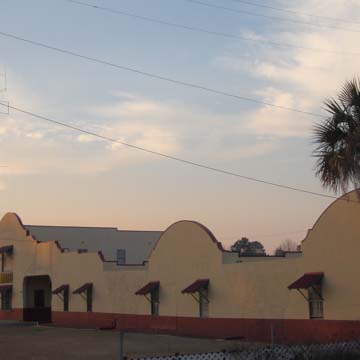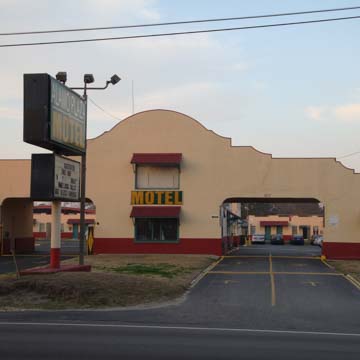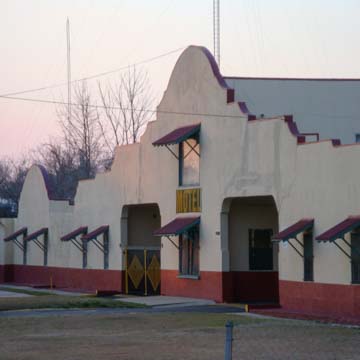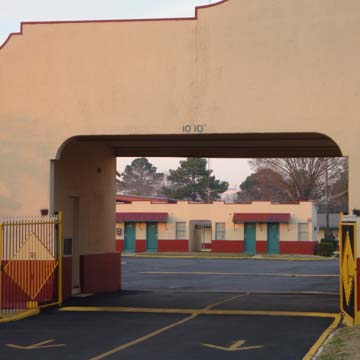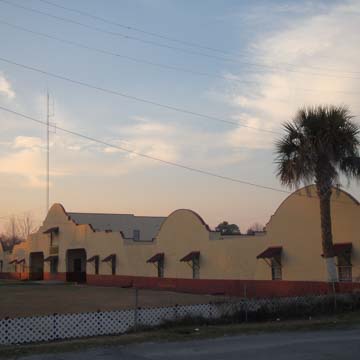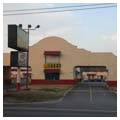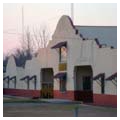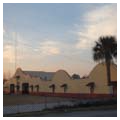You are here
Alamo Plaza Motel
As automobile usage increased by the mid-twentieth century, roadside motels emerged as a building typology serving the leisure and business needs of the traveling middle class. While Travelodge (1935), Best Western (1947), and Holiday Inn (1952) remain some of the most well-known franchises, the first chain motel in the U.S. was the Alamo Plaza Hotel Courts founded by Edgar Lee Torrance in 1929. Three Alamo Plaza motels were built in Georgia, one along the Dixie Highway on the south edge of Atlanta (1948), since remodeled and renamed the Santa Fe Villas; one in Augusta (1958) near Fort Gordon, restored in 1998 and now private resort; and this motel in Savannah, which opened on West Bay Street in 1955.
Torrance and his partner Drummond W. Bartlett opened their first Alamo Plaza as the Alamo Plaza Tourist Apartments in Waco, Texas, in 1929. They intended to develop a new option for temporary lodging which, at the time, was limited to expensive downtown hotels or informal roadside tourist cabins, the former with unwanted amenities that required tipping and the latter with few amenities at all. Torrance envisioned a new type of accommodation that would attract passersby with a distinctive image. Torrance intended to let the architecture be the advertisement, encouraging the public to “Remember the Alamo Plaza” by adopting for his motor courts the facade of the historic San Antonio mission church, thus linking commercial lodging to Texas patriotism. The Mission Revival iconography became one of many architectural themes eventually adopted by motel chains, which began to standardize their forms to create a recognizable architectural style that would entice travelers off the road using an evocative and familiar visual language.
Following his first Alamo Court in Waco, Torrance opened a second in 1931 in Tyler, Texas, and partnered with his son-in-law, W. Howard Lee, in Houston to erect others; he soon owned seven Alamo Courts in five southern states, all in the Mission Revival style. Like other motels of the Alamo Court chain, the long billboard facade of repeated Alamo gable profiles and stucco surfaces stretched along the roadside, giving passing motorists time to view the “Vacancy” sign and picturesque building forms on display. The billboard-like facade connects individual rooms, with other freestanding units and parking courts located behind. The ordinariness of the motel units was hidden—the whole is screened from the street by the “stage prop” elevation of the repeated Alamo facades. There was some variation in the design of the motel chain: some courts were arranged in repeated U-plan; some contained a swimming pool; others borrowed additional Spanish motifs such as vigas to adorn further their exterior faces. The whole, in each instance, as here in Savannah, resembled a Hollywood set, due in particular to the false-front character of the facade.
To stay competitive, in 1936, Torrance began offering free telephones in each guest room (other proprietors used coin boxes). Later, Alamo Courts offered free televisions, and each room featured Simmons metal furniture and Beautyrest mattresses. While restaurants were not part of the motel chain, eating establishments were usually sited nearby. By 1955, when the Savannah Alamo Plaza Hotel Court opened, there were more than twenty Alamo Courts in operation, “catering to those who care.” Torrance initially maintained a policy, encouraged by social standards of his day, to not admit “couples with local driver’s licenses.” His target clientele was traveling salesmen and tourists, and the Savannah motel, located just off U.S. highways 17 and 80 (major tourist routes to Florida) continued to thrive on the edge of a popular tourist town until the construction of I-95, which then became the principal north-south coastal route. Indeed, the interstate highways were the death knell for many of the early motel chains.
The facility was renamed the Alamo Plaza Motel in 1977. It remains extant today as a provider of short-term housing for local workers.
References
Jakle, John A., Keith A. Sculle, and Jefferson S. Rogers. The Motel in America. Baltimore: Johns Hopkins University Press, 1996.
Writing Credits
If SAH Archipedia has been useful to you, please consider supporting it.
SAH Archipedia tells the story of the United States through its buildings, landscapes, and cities. This freely available resource empowers the public with authoritative knowledge that deepens their understanding and appreciation of the built environment. But the Society of Architectural Historians, which created SAH Archipedia with University of Virginia Press, needs your support to maintain the high-caliber research, writing, photography, cartography, editing, design, and programming that make SAH Archipedia a trusted online resource available to all who value the history of place, heritage tourism, and learning.














